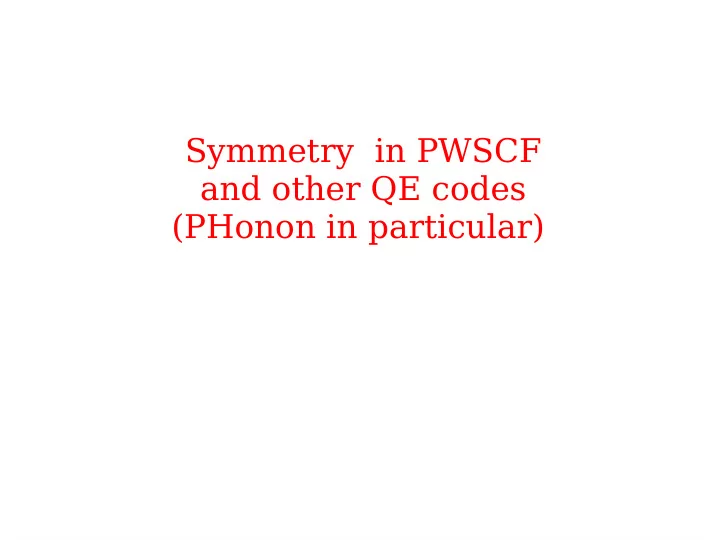

Symmetry in PWSCF and other QE codes (PHonon in particular)
Gamma point When dealing with large systems Gamma point sampling is often used. CP is written with Gamma point sampling only. This is due to special properties that can be exploited for Gamma that make the calculation faster than for a generic k
Special properties of Gamma point If Gamma point is used the wave functions can be assumed to be real in real space ! This imposes constraints in its reciprocal space representation hence only half of the PW component are independent and need to be stored/processed.
Special properties of Gamma point Operators in Reciprocal Space require simple adjustments to cut in half the cost Normalization: Where are the G vectors whose first cartesian component is positive Kinetic energy:
Special properties of Gamma point Operators in Real Space can exploit REAL Arithmetics Potential times wavefunction: do ir=1, nrr vpsi(ir) = v(ir) * psi(ir) end do one COMPLEX multiplication takes 4 REAL ones calls to REAL blas and lapack routines are similarly more efficients and use less memory.
Special properties of Gamma point FFT operations are a big part of the calculation ig = FFT index of a G aux(ig )= psi(ig,ibnd) + (0.0,1.0) * psi(ig,ibnd+1) img = FFT index of -G aux(img)= CONJG(psi(ig,ibnd))+ (0.0,1.0) * CONJG(psi(ig,ibnd+1) call invfft (aux) psir(ir, ibnd) = REAL ( aux(ir) ) psir(ir, ibnd+1) = DIMAG( aux(ir) ) the FFT of two wfcs at Gamma can be performed at the same time! Similarly for the fwfft aux(ir) = CMPLX( psir(ir, ibnd),psir(ir, ibnd+1)) call fwfft (aux) psi(ig, ibnd) = 0.5 *( aux(ig) + CONJG(aux(img)) ) psi(ig, ibnd+1) = 0.5 *( aux(ig) – CONJG(aux(img)) )/(0.0,1.0) Exploiting these properties the gamma_only calculations are at least twice faster and use less memory !
Crystal Symmetry In calculations involving generic k-points crystal symmetry is exploited to reduce the amount of work needed for a given desired k-point sampling
Time Reversal Symmetry A symmetry that is always present is the one due to time reversal (reality of the hamiltonian) This implies [eig.val. ] So we can always use only half of the k-points.
Crystal Symmetry Crystal symmetry operations are in general (im)proper rotations with possibly a fractional translation. Crystal symmetry operations form a Group.
Crystal Symmetry The Hamiltonian is invariant under sym.ops. effect on a wfc: if is an eigenfunction [eig.val ] so is [eig.val ]
Symmetry and Bloch states Effect on Block states: if [eig.val. ] then
Symmetry and Bloch states Effect on Block states: if [eig.val. ] then [eig.val. ]
Symmetry and Charge Density
Symmetry and Charge Density
Symmetry and Charge Density
Symmetry and Charge Density Where with
Symmetry and Forces where with
Symmetry and Stress where with
Symmetry and Dynamical Matrix where with
Symmetry and Dynamical Matrix Displacements for all q in the star, all atoms in the cell, all Cartesian directions would be needed to advance scf dfpt this is most often too much (except for bulk semiconductors...)
Symmetry and Dynamical Matrix If we reduce the symmetry to only those sym.ops. that do not rotate the q vector this can be reduced to displacements for all atoms in the cell, all Cartesian directions The price is an increased number of k-points +q x => This is most often still too much
Symmetry and Delta rho If we reduce the symmetry to only those sym.ops. that do not rotate the q vector We can perform DFPT calculations on small groups of patterns that transform among themselves → irreducible representations
Symmetry and Delta rho Let's have Let's assume we have irr. reps.
Symmetry and Delta rho Let's have How do we get the irr. reps. ? 1) Generate a Random Matrix RM 2) Symmetrize it 3) Diagonalize it 4) each degenerate level identifies an irr.rep.
Recommend
More recommend